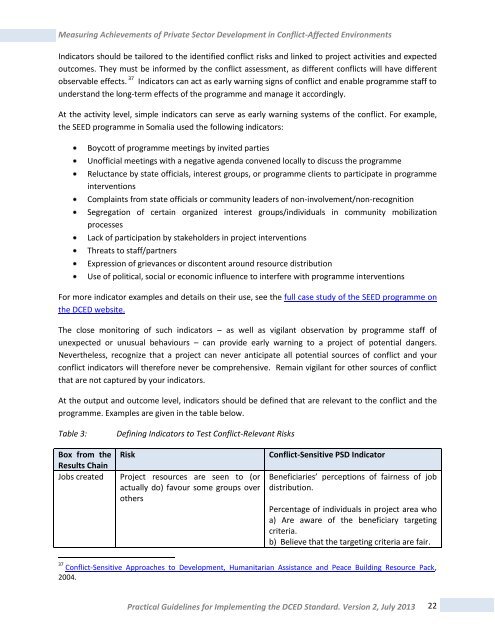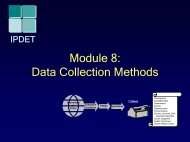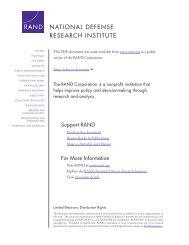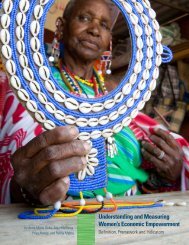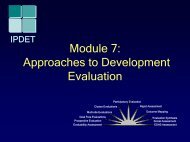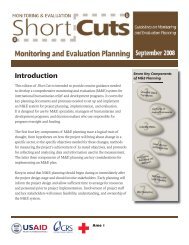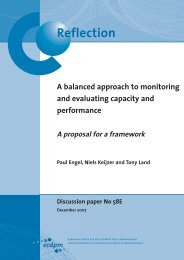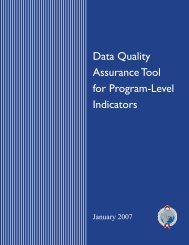Measuring Achievements of Private Sector Development in ... - DCED
Measuring Achievements of Private Sector Development in ... - DCED
Measuring Achievements of Private Sector Development in ... - DCED
Create successful ePaper yourself
Turn your PDF publications into a flip-book with our unique Google optimized e-Paper software.
<strong>Measur<strong>in</strong>g</strong> <strong>Achievements</strong> <strong>of</strong> <strong>Private</strong> <strong>Sector</strong> <strong>Development</strong> <strong>in</strong> Conflict-Affected Environments<br />
Indicators should be tailored to the identified conflict risks and l<strong>in</strong>ked to project activities and expected<br />
outcomes. They must be <strong>in</strong>formed by the conflict assessment, as different conflicts will have different<br />
observable effects. 37 Indicators can act as early warn<strong>in</strong>g signs <strong>of</strong> conflict and enable programme staff to<br />
understand the long-term effects <strong>of</strong> the programme and manage it accord<strong>in</strong>gly.<br />
At the activity level, simple <strong>in</strong>dicators can serve as early warn<strong>in</strong>g systems <strong>of</strong> the conflict. For example,<br />
the SEED programme <strong>in</strong> Somalia used the follow<strong>in</strong>g <strong>in</strong>dicators:<br />
Boycott <strong>of</strong> programme meet<strong>in</strong>gs by <strong>in</strong>vited parties<br />
Un<strong>of</strong>ficial meet<strong>in</strong>gs with a negative agenda convened locally to discuss the programme<br />
Reluctance by state <strong>of</strong>ficials, <strong>in</strong>terest groups, or programme clients to participate <strong>in</strong> programme<br />
<strong>in</strong>terventions<br />
Compla<strong>in</strong>ts from state <strong>of</strong>ficials or community leaders <strong>of</strong> non-<strong>in</strong>volvement/non-recognition<br />
Segregation <strong>of</strong> certa<strong>in</strong> organized <strong>in</strong>terest groups/<strong>in</strong>dividuals <strong>in</strong> community mobilization<br />
processes<br />
Lack <strong>of</strong> participation by stakeholders <strong>in</strong> project <strong>in</strong>terventions<br />
Threats to staff/partners<br />
Expression <strong>of</strong> grievances or discontent around resource distribution<br />
Use <strong>of</strong> political, social or economic <strong>in</strong>fluence to <strong>in</strong>terfere with programme <strong>in</strong>terventions<br />
For more <strong>in</strong>dicator examples and details on their use, see the full case study <strong>of</strong> the SEED programme on<br />
the <strong>DCED</strong> website.<br />
The close monitor<strong>in</strong>g <strong>of</strong> such <strong>in</strong>dicators – as well as vigilant observation by programme staff <strong>of</strong><br />
unexpected or unusual behaviours – can provide early warn<strong>in</strong>g to a project <strong>of</strong> potential dangers.<br />
Nevertheless, recognize that a project can never anticipate all potential sources <strong>of</strong> conflict and your<br />
conflict <strong>in</strong>dicators will therefore never be comprehensive. Rema<strong>in</strong> vigilant for other sources <strong>of</strong> conflict<br />
that are not captured by your <strong>in</strong>dicators.<br />
At the output and outcome level, <strong>in</strong>dicators should be def<strong>in</strong>ed that are relevant to the conflict and the<br />
programme. Examples are given <strong>in</strong> the table below.<br />
Table 3:<br />
Def<strong>in</strong><strong>in</strong>g Indicators to Test Conflict-Relevant Risks<br />
Box from the<br />
Results Cha<strong>in</strong><br />
Jobs created<br />
Risk<br />
Project resources are seen to (or<br />
actually do) favour some groups over<br />
others<br />
Conflict-Sensitive PSD Indicator<br />
Beneficiaries’ perceptions <strong>of</strong> fairness <strong>of</strong> job<br />
distribution.<br />
Percentage <strong>of</strong> <strong>in</strong>dividuals <strong>in</strong> project area who<br />
a) Are aware <strong>of</strong> the beneficiary target<strong>in</strong>g<br />
criteria.<br />
b) Believe that the target<strong>in</strong>g criteria are fair.<br />
37 Conflict-Sensitive Approaches to <strong>Development</strong>, Humanitarian Assistance and Peace Build<strong>in</strong>g Resource Pack,<br />
2004.<br />
Practical Guidel<strong>in</strong>es for Implement<strong>in</strong>g the <strong>DCED</strong> Standard. Version 2, July 2013<br />
22


